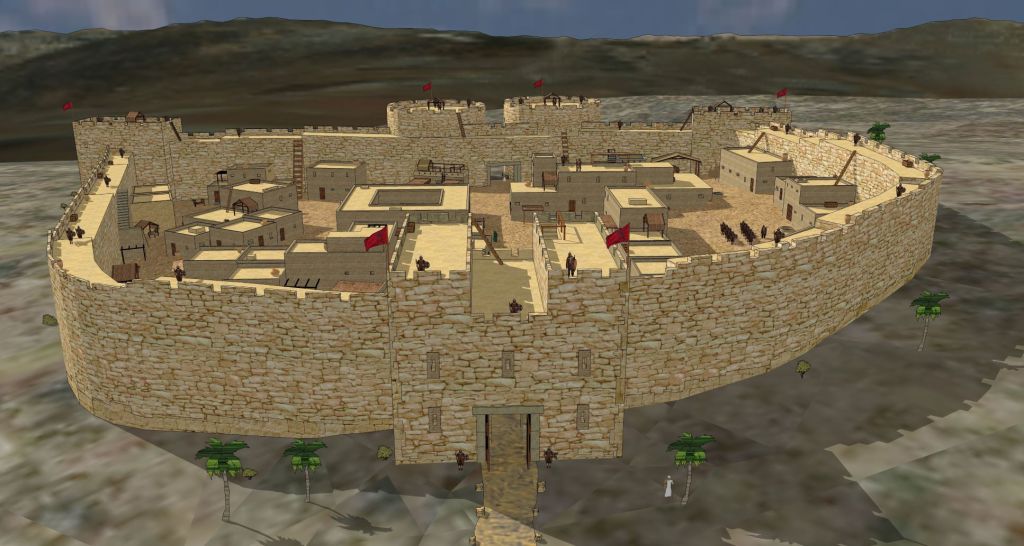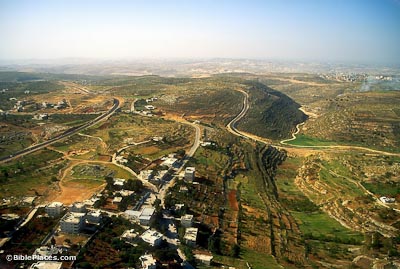
Recreation of the Khirbet el-Maqatir fortress
https://biblearchaeology.org/current-ev … us-ephraim
After the destruction of Jericho, the next city they attacked was Ai.
Josh 7:2-5 (NIV)
2 Now Joshua sent men from Jericho to Ai, which is near Beth Aven to the east of Bethel, and told them, “Go up and spy out the region.” So the men went up and spied out Ai. 3 When they returned to Joshua, they said, “Not all the army will have to go up against Ai. Send two or three thousand men to take it and do not weary the whole army, for only a few people live there.” 4 So about three thousand went up; but they were routed by the men of Ai, 5 who killed about thirty-six of them. They chased the Israelites from the city gate as far as the stone quarries and struck them down on the slopes. At this the hearts of the people melted in fear and became like water.
Most likely, Ai is at present day Khirbet el-Maqatir, which is just west of Jericho along the Joppa-Amman road.

https://biblearchaeologyreport.com/2019 … -sites-ai/
Based on its strategic location and archaeological findings there, Khirbet el-Maqatir appears to have been a northern border fortress for the Jerusalem city-state at the time of the Conquest.
https://biblearchaeology.org/current-ev … us-ephraim
The location matches the geographic description of the Bible.
Joshua 7 says it was near Beth Aven and east of Bethel.
Josh 7:2 (KJV)
2 And Joshua sent men from Jericho to Ai, which [is] beside Beth-aven, on the east side of Bethel, and spoke unto them, saying, Go up and view the country. And the men went up and viewed Ai.
Have an ambush site on the west side of Ai.
Josh 8:9 (KJV)
9 Joshua therefore sent them forth: and they went to lie in ambush, and abode between Bethel and Ai, on the west side of Ai: but Joshua lodged that night among the people.
Have a valley north of Ai.
Josh 8:11 (KJV)
And all the people, [even the people] of war that [were] with him, went up, and drew nigh, and came before the city, and pitched on the north side of Ai: now [there was] a valley between them and Ai.
If Kh. el-Maqatir were to prove to be Ai archaeologically, its location fits the biblical record well. The deep Wadi Sheban to the west provides a perfect location for the ambush forces of the Israelites to hide. Joshua’s command post was on the hill just east (left) of the modern road and he fled east away from the wadi allowing the ambush force to attack from behind.
Aerial view from north:

https://www.bibleplaces.com/maqatir/
It should be a relatively small city.
Josh 7:3 (KJV)
And they returned to Joshua, and said unto him, Let not all the people go up; but let about two or three thousand men go up and smite Ai; [and] make not all the people to labor thither; for they [are but] few.
Excavations at Khirbet el-Maqatir have revealed a small border fortress dating to the Middle and Late Bronze Ages. Although only about 2.5 acres in size the foundation of the fortification walls on the north and west side were found to be 13 feet wide. On the north side of the fortress, a four-chambered gate was unearthed.
https://biblearchaeologyreport.com/2019 … -sites-ai/
It was burned by fire.
Josh 8:8 When you have taken the city, set it on fire. Do what the LORD has commanded. See to it; you have my orders.”
Excavations at Khirbet el-Maqatir revealed ample pottery dating to the Late Bronze Age I, much of which had been refired in a site-wide conflagration.
https://biblearchaeologyreport.com/2019 … -sites-ai/
Artifacts found conform to the early date of the Exodus.
Three Egyptian scarabs were found at the site, including two from the period of the fortress: one dating to the the Middle Bronze III period (ca. 1650–1485 B.C.) and another rarer scarab dating to the 18th Dynasty, likely in the reign of Amenhotep II (ca. 1455-1418 B.C.).
https://biblearchaeologyreport.com/2019 … -sites-ai/
Whereas in Jericho they could not take any plunder, at Ai they could.
Josh 8:1-2 (NIV)
1 Then the LORD said to Joshua, “Do not be afraid; do not be discouraged. Take the whole army with you, and go up and attack Ai. For I have delivered into your hands the king of Ai, his people, his city and his land.
2 You shall do to Ai and its king as you did to Jericho and its king, except that you may carry off their plunder and livestock for yourselves. Set an ambush behind the city.”
No jars of grain have been found unlike Jericho.
It was made a permanent heap of ruins.
Josh 8:28 (NIV)
28 So Joshua burned Ai and made it a permanent heap of ruins, a desolate place to this day.
Following the destruction of the Late Bronze I fortress it was abandoned and left exposed to the elements, later scavengers and the farmer’s plow. Much of the eastern half of the Late Bronze I fortress was robbed out by the later Hasmonean builders. The western half was similarly robbed out when the Byzantine church and monastery was constructed on the summit of the hill 220 yds to the northwest. Subsequent to the Byzantine period there has been additional looting of the site. The foundation of the west half of the gate and remnants of the fortress, however, have survived. These sparse remains are visible on the surface or can be found just below the surface.
https://biblearchaeology.org/current-ev … us-ephraim
One thing that was built nearby was an ancient Byzantine monastery, as possibly a memorial to Ai.
While a church at Khirbet el-Maqatir north of Jerusalem has long been identified, only recently did it become known that the site included a full monastery.
https://www.galaxie.com/article/bspade12-3-05
Byzantine monks built a large monastery on the site in the 4th c. A.D. that may help in the identification of this site as Ai. The earliest reports by Edward Robinson in 1838 show that the local peoples thought Kh. el-Maqatir was Ai and it is possible that this church preserved the memory of this identification.
https://debatingchristianity.com/forum/viewtopic.php?p=1083098#p1083098